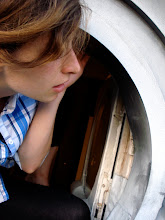
My first job was at a breakfast cafe in my sleepy hometown. The place was pretty settled among members of the community, and, for that reason (as well as costs) it hadn't gone through any of the repairs and renovations that it truly needed. Practically every piece of machinery in the place was in a constant state of disrepair. Because of this fact, I consider it the ideal "first job"- any place that I worked at afterward seemed like a luxury.
Take, for example, the espresso machine. The machine itself was the most archaic, coffee grind- covered contraption I've ever seen. Perhaps the only recognizable part was the milk steamer (which was also the only portion that worked). The temperamental machine had a tendency to explode about five times a day, releasing the still-brewing espresso on the unfortunate staff member that happened to press the ground beans to the metal filter. Thus, when someone ordered a double latte, I found myself emitting a deep sigh as I approached the machine with caution, envisioning how I would coax it into producing espresso without losing another shirt to a coffee-spewing temper tantrum.
The other slightly old- fashioned aspect of the place was the fact that there was no computerized ordering system for servers. In fact, we'd take down orders on a piece of paper and bring it to the kitchen, handing it directly to the chef at the burners. While I disdained the espresso machine, I loved this aspect of the job. I felt as if I was truly setting up a line of communication between the kitchen and the customer.
But there was actually another reason that I loved running these pieces of paper back and forth between the kitchen and the main floor- Oswaldo. Oswaldo was the gentle giant of the kitchen, a middle-aged Peruvian chef with gray hairs peeking out of his beard and friendly eyes. He had an innate ability to prepare up to eight omelets at a time on that multiple-burner stovetop. He sang in a deep tenor as he carried out the trash bags at the end of the day. Best of all, he never got angry. He'd just say: "es ok".
At the time my Spanish skills weren't too great. After all, I hadn't gotten to the "food terminology" section of the Spanish high school curriculum. Oswaldo got a kick out of my attempts to explain complicated orders... and began to predict what I was going to say. After all, I began every attempt to communicate an order with "Well. it's a little complicated". After I handed him the order, an exchange between us might have gone like this:
Kelsey: "Oswaldo... er....esta persona quiere...er...es un poco-"
Oswaldo: "Ya lo se. Un poco complicado? Es ok. A ver... huevos revueltos con cebolla... es ok."
Oswaldo's combination of English and Spanish into the little phrase "es ok" seemed to calm me for a bit. Then, upon realizing that I should probably just stop trying to speak in Spanish to him, I'd reel, running out of the kitchen to leave the blaring mariachi music for the hustle and bustle of the main floor.
Yet, for some reason, I kept trying to explain things in broken Spanish. One day, I think Oswaldo realized that if I wasn't going to give up trying to speak Spanish to him, he'd have to start teaching me a bit. So that's how it began.
Well, actually it began with the Spanish word for egg yolk: "yema".
When a customer had ordered an egg-white omelet, I brought the order to Oswaldo. He turned his back temporarily on the sizzling omelets and bacon to tell me: "sin yema- Y-E-M-A". Our mini-kitchen lessons continued- with jamon, tocino, ajo, cebolla, pimientos.... he was a better teacher than he probably realized. I was grateful for his patience, and even started trying to crack jokes with him (he didn't find any of them funny). But really, it's people like Oswaldo that influenced this deep love that I have for Spanish language. I have learned more Spanish from real people with beautiful stories and incredible talents than I did in my years studying vocabulary lists and reading short stories in the classroom.
I'd walk home my long days at work with a leftover scone in hand and a string of new Spanish words running through my head. The scones were a pretty phenomenal end to the day- and I had a lot of good ones to choose from- they had everything from the traditional oatmeal raisin to the more adventurous pumpkin spice and cranberry orange. Yet, my favorite scone was the currant scone. I loved how each bite was permeated with currants and a buttery crumble of scone. So I thought, slightly in honor of my first job with Oswaldo, I'd replicate the currant scones.
I used this recipe by Dorie Greenspan- it yields a light scone, perfect for a lazy Sunday morning with a cup of milky coffee.
Dorie Greenspan's Raisin Scones (with currants)
shamelessly stolen from her website!1 large egg
1/2 cup milk
2 cups all-purpose flour
2 1/2 Tbsp sugar
1 Tbsp baking powder
1/2 tsp salt
6 Tbsp cold butter, cut into bits
3/4 cup raisins (or currants)
Preheat the oven to 400ºF. Mix the egg and milk together in one bowl and the flour, sugar, baking powder, and salt in another.
Place the butter into the flour (don't forget to cut it into smaller pieces!) and, using your fingers, mash the two ingredients together until the mixture becomes "pebbly". Add the milk and egg. Mix with a fork until everything is incorporated. Add the raisins (or currants) and stir a few more times.
As Dorie says: "Spoon a dozen mounds of dough onto a foil-lined baking sheet and bake for 20 to 22 minutes, or until the scones are golden brown. Cool for a few minutes. Serve warm with butter or jam, or a little of each."


No comments:
Post a Comment